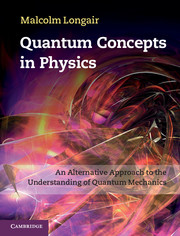Book contents
- Frontmatter
- Contents
- Preface
- Acknowledgements
- Part I The Discovery of Quanta
- Part II The Old Quantum Theory
- 4 The Bohr model of the hydrogen atom
- 5 Sommerfeld and Ehrenfest – generalising the Bohr model
- 6 Einstein coefficients, Bohr's correspondence principle and the first selection rules
- 7 Understanding atomic spectra – additional quantum numbers
- 8 Bohr's model of the periodic table and the origin of spin
- 9 The wave–particle duality
- Part III The Discovery of Quantum Mechanics
- Epilogue
- Notes
- References
- Name index
- Subject index
7 - Understanding atomic spectra – additional quantum numbers
from Part II - The Old Quantum Theory
Published online by Cambridge University Press: 05 February 2013
- Frontmatter
- Contents
- Preface
- Acknowledgements
- Part I The Discovery of Quanta
- Part II The Old Quantum Theory
- 4 The Bohr model of the hydrogen atom
- 5 Sommerfeld and Ehrenfest – generalising the Bohr model
- 6 Einstein coefficients, Bohr's correspondence principle and the first selection rules
- 7 Understanding atomic spectra – additional quantum numbers
- 8 Bohr's model of the periodic table and the origin of spin
- 9 The wave–particle duality
- Part III The Discovery of Quantum Mechanics
- Epilogue
- Notes
- References
- Name index
- Subject index
Summary
Optical spectroscopy, multiplets and the splitting of spectral lines
The achievements described in Chap. 6 represented a remarkable advance in the understanding of quantum phenomena, but there remained major challenges which were ultimately to undermine the successes of the old quantum theory. Continuing advances in spectroscopy enabled high resolution spectra to be obtained and, with the ability to place the sources of emission in strong electric and magnetic fields, the full complexity of atomic and molecular spectra became apparent. Atomic spectra display regularities, for example, the series spectra of elements such as sodium and calcium which could be described by the Rydberg formula (Sect. 1.6). Some of the most prominent spectral features consisted, however, of multiplets, meaning the splitting of a line into a number of separate lines with similar wavelengths. Examples of multiplets are illustrated in Fig. 7.1, derived from observations of the photosphere of the Sun from the Pic du Midi observatory.
The simplest lines are singlets, the example of the Hα line of the Balmer series of hydrogen being shown in Fig. 7.1a. In fact, the line is a very narrow doublet, which Sommerfeld attributed to the effects of special relativity upon the circular and elliptical orbits of electrons of the same principal quantum number (Sect. 5.3). The splittings we are interested in here are very much larger effects. The classic example of a doublet is the splitting of the sodium D line into two bright components labelled D1 (589.592 nm) and D2 (588.995 nm) (Fig. 7.1b).
- Type
- Chapter
- Information
- Quantum Concepts in PhysicsAn Alternative Approach to the Understanding of Quantum Mechanics, pp. 137 - 154Publisher: Cambridge University PressPrint publication year: 2013



